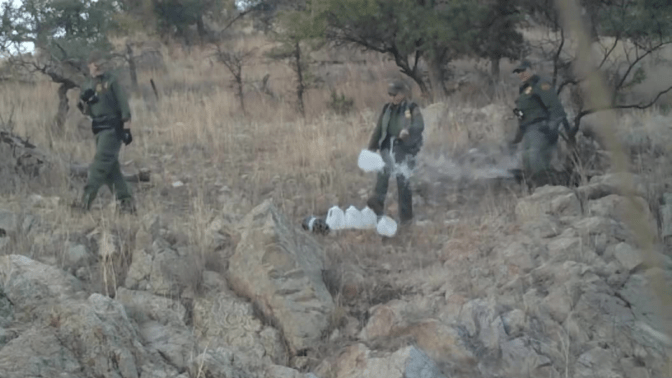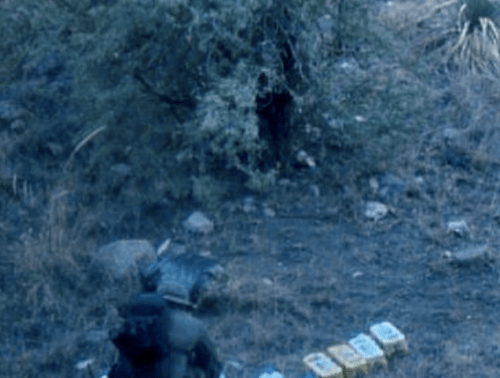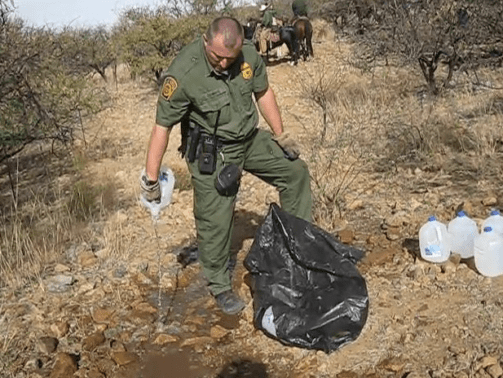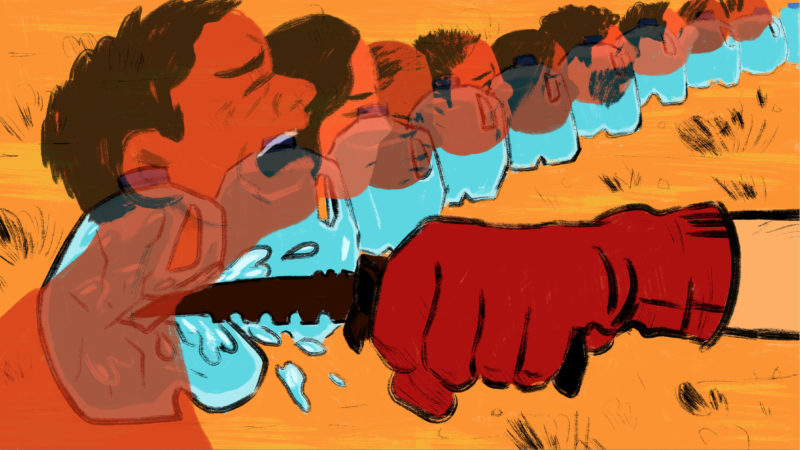Who kindly sets a wanderer on his way
Does e’en as if he lit another’s lamp by his:
No less shines his, when he his friends hath lit.
–Ennius
On February 10, 2017, at around 4:15 pm, a white male Border Patrol agent parked his truck in the shadow of a rusted windmill outside of Arivaca, Arizona. He was about two miles, as the crow flies, north of the Mexican border. The temperature was in the mid-eighties. A slight breeze swayed the ocotillo and mesquite branches. The sky was clear. The agent turned off his truck and stepped into the dirt. Maybe he radioed in his position. Maybe he finished his sandwich, or packed his lip with tobacco. Maybe he pissed in the weeds. A cow lowed somewhere nearby. A raven alighted on a branch. A saguaro towered sedately.
The agent shouldered his Camelback backpack, strapped his M4 Carbine over his shoulder, and put on his green boonie hat. He pulled on his gloves and folded his sleeves up his forearms. After locking his truck, he walked a few dozen yards down the uneven dirt road before turning into the high grass of a narrow trail. In ten minutes, stopping occasionally to scan the hillsides, he entered into a rocky wash. As he hiked south, stepping over boulders and shags of rock, between cat claw acacia and tufts of grass, he saw the remnants of other people who had walked before him—discarded blankets, backpacks with broken straps, and empty, sun-brittled plastic bottles. After about thirty minutes he came to the water cache. Maybe he hummed under his breath. Maybe he stopped to scan the hills with his binoculars—the scrub hills green with recent rains.
At the cache site, just off the thin dirt trail, were eight one-gallon bottles of water set in a row and, slightly further up the slope, four flats of pinto beans—four packs holding eight fifteen-ounce Sun Vista pop-top cans. The supplies were left by humanitarian-aid volunteers. On the opposite slope they also left a camera, which, when triggered by the agent’s movement, started to record.
The typical traffic on the trail consists of ranch hands, Border Patrol agents, militia members, humanitarian-aid volunteers, people hefting backpacks of marijuana, and the errant birder or desert rat. Animals walk it, too: mountain lions, coyotes, fox, skunk, coatimundi, jackrabbits, and deer. But it is primarily roaming cattle and migrants on their way north who flatten the grass on this trail.
The migrants’ stories are as varied as anybody else’s, but most of them come from poor southern regions of Mexico or the northern triangle of Central America. Most are fleeing violence or extreme poverty. Some have lived for long stretches in the US, have roots, families, jobs, loves, and daily routines there, and are returning to a home as much as fleeing one. Some, the poorest, make the perilous journey clinging atop a roaring freight train, which they call the Beast. Sometimes the trains buck them off, killing and maiming dozens a year. Some take their chances — skirting Mexican immigration checkpoints — and ride busses. Almost all have paid expensive smuggling fees.
All have walked at least one day, and most of them have spent a night sleeping on the ground—scared, hot, cold, bug-bitten, thorn-scratched, sometimes raped, often terrified, and always uncomfortable. From the cache, there is at least one more day and night ahead; probably more. If they twist an ankle walking at night on the uneven ground, or grow a blister, or drink from a cowtank or stagnant puddle and get diarrhea, their chances of dying are high. And, if they keep walking, they are hunted by a paramilitary-style law enforcement agency, one of the largest in the world, with a well-established history of violence.
Among these seemingly endless perils, it is the weather that poses the most immediate danger. Even in winter the temperatures in the Sonoran Desert are extreme, and, except for giardia-contaminated cow tanks and puddles, there is almost no water. For a three-day walk—which is the shortest most migrants will make—it is impossible to carry sufficient water. Medical experts recommend, for these conditions, at least one and a half gallons per day. For a three-day walk, that’s almost forty pounds of water. Throw in food and clothes, and a migrant would have sixty pounds on their back, which, given the terrain, is unfeasible. Many carry one or two gallons. Most become desperately, dangerously thirsty after about two days of walking. Some fare worse. If they don’t find water, they are in danger of heat exhaustion, severe dehydration, and death.
The risk isn’t happenstance: US Border Patrol policy intentionally pushes migrants into crossing in regions where they are more likely to suffer and die. An analogous policy in the interior of the country would be rerouting a sidewalk to force pedestrians to hazard straight across a busy highway, and chasing them with armed helicopters as they do so.
The agent, after scanning the hills, looking up and back down the trail, squatted to inspect the cache. The water bottles had hearts drawn on them, as well as uplifting messages written in Spanish: Agua Pura, ¡Ánimo! ¡Que Vayan con Suerte! He shifted his rifle and awkwardly readjusted his squat. Then he took out his knife and began lining up the water bottles. One by one, he stabbed them, sticking in his knife and then pulling it back out along with a little gulp of water. He stabbed all eight bottles. The water bled out, soaking the dirt.

When you die of dehydration or heat stroke—the most common causes of death among border crossers in southern Arizona—you go insane. Lack of water in your body leads to hypovolemia, insufficient blood in your circulatory system, which dries out your brain. Your skin begins to shrivel, and your body redirects blood away from non-vital organs. Then—without your kidneys working as a filter—your own blood begins to poison you. Without enough water to sweat, your entire body becomes feverish; by then your brain is not only drying out, it is cooking. Severe exertional heat illness—because, somehow, you’re still walking north—leads to vomiting, dizziness, disorientation, and the breakdown of the heart muscle. The pain is slow, complete. Your tongue begins to whiten and swell, and you strip off your clothes, stumble through the thorns and shin daggers, until, finally, you prostrate yourself to the blaze of the sun. In the desert, the chain of causation is short—a day without water, then your corpse is torn apart by animal scavengers. The bottles of water that agent was stabbing may just as well have been the border crossers’ necks.
Excruciating death is the fate, annually, of hundreds of people who attempt to cross the US-Mexico border. Since the turn of the century, over seven thousand are known to have died. Many more have disappeared, lost into the desert, their remains scattered by scavengers and weather. US Border Patrol’s culpability for these deaths is highlighted by a recent report from No More Deaths (I was part of the team that wrote it), which brings what for some has remained an abstraction—government policy clashing with human life—into sharp relief.
The No More Deaths (NMD) report finds that, over a two-year period in just one small corridor of the Arizona desert, 3,586 water bottles left out for thirsty migrants were vandalized. After conducting a detailed geographical analysis and collecting video evidence, we concluded that Border Patrol agents were the most consistent culprit.
To capture the Border Patrol in flagrante delicto, we placed motion-activated trail cameras near our water caches catching footage of agents who appeared armed as if for battle. (The likelihood of a Border Patrol agent being killed while on duty—apart from dying in single-vehicle accidents—is exceedingly low.) Despite considerable setbacks—lost, stolen, wind-shifted, mis-functioning, animalized, or poorly aimed cameras—at least four times we documented agents confiscating or vandalizing our caches. The footage was shocking to witness. After years of studying, investigating, writing about, and altogether embroiling myself in the reality of the border and the callousness and cruelty of US immigration policies, I was dumbfounded at the blatant inhumanity of the act. How could a human being intentionally deprive another human being—a thirsty human being—of water?

The violence haunted me. I remember coming upon one water cache (our camera had been over-triggered by windblown grass, exhausting its memory before capturing the crime) with two fellow volunteers where a massacre seemed to have taken place: water bottles kicked, slashed, drained; cans of beans stabbed, smashed against rocks, popped open and left to rot; shards of plastic and aluminum shrapnelled across the desert trail.
Surveying the scene, I wondered: Can you murder water?
The definition of “humanity” (the word is related to humus, or dirt) hides somewhere between two antipodes: the totality of featherless bipeds and seven-plus billion images of god. The word, with all of its dirt, bombast, and abstraction, rings of both collectivity and compassion. To act with humanity is to act with empathy: it is to do the kind or decent thing. Such usage suggests an inherent goodness in us, though the definition is more aspirational than accurate. (The word’s two other usages further undercut any sense of loftiness: underfunded academic departments and a mostly empty—with some exceptions—type of organizational charity.)
A crime against humanity is not simply an act devoid of the second sense of the word—of decency—but also encapsulates and targets the first sense as an act against the collective. It is an act that somehow—when perpetrated, suffered, witnessed, or merely heard tell of—has the capacity to affect all of us.
The term “crimes against humanity” came into popular and legal potency after World War II (though it was first mentioned by Robbespierre in 1792, when the Jacobin accused the king of being not only a traitor to France, but a “criminal toward humanity”) as the international community struggled to imagine how to define and prosecute the atrocities committed during the holocaust. The legal definition, according to the 1945 Nuremberg Charter, is “murder, extermination, enslavement, deportation, and other inhumane acts committed against any civilian population… or persecutions on political, racial or religious grounds.” During and since the Nuremberg trials, successive generations have labored to consequentially apply the definition. At what point does a crime—a murder, multiple murders, or mass murder—pass the threshold and become more than murder?
The abstraction is, perhaps, part of the subjective nature of what defines the experience of humanity as much as crimes against it. Philosopher Christopher Macleod underscores the dearth and difficulty of philosophical inquiries into the definition of such crimes, and claims another understanding of “humanity”: humanness, or the value of being human. And though standard legal definitions of crimes against humanity do not specify which of the multiple understandings are targeted, it may well be all of them.
The purpose of human rights, political theorist David Miller writes in Strangers in Our Midst, “is to identify a threshold that must not be crossed rather than to describe a social ideal.” Merely crossing that threshold, however—a violation of human rights—isn’t enough to constitute a crime against humanity. Such a crime is more than a breach; it is, rather, a deliberate and concerted attack not just on a human being, but on what makes us human. As philosopher Daniel Heller-Roazen explains, humanity is something that marks us, and yet “to be marked by the quality of ‘humanity,’ it seems, is only ever to approach it.” What makes us human includes striving towards our a sense of humanity, as in harboring enough hope (or fear) to walk across a desert, to approach and cross a border.
The value of being human is, perhaps, what allows us to build off of those rights we have popularly defined as fundamental. The value of humanness is the surpassing of the fundamental rights of life and free speech, for example, into love and song. Or the surpassing of the fundamental right of freedom into joy or art.
Humans don’t seek just life, or, as Italian philosopher Giorgio Agamben (leaning on Hannah Arendt) has termed it, bare life—a reduction of the human to mere biological mechanism. A human right so inherent that it need not be articulated—or so one would think—is the right to water. Without water—as demonstrated by the water protectors’ fierce defense in North Dakota—even bare life is a non-starter. These rights are the baseline that make it possible for a person to engage in, for example, luge, Noh, pickling, and politics (or whatever else you might be into). The concept of humanity, the value of being human, is both aspirational and inescapable. We are trapped in it as much as we are inspired by it. A crime against humanity is an act that impinges on the definition more than the subject—humans reduced to bare life are, of course, still human.
The agent stabbing water bottles in the desert is not even, at least by the common legal sense, committing murder—his knife doesn’t come close enough to his victims. Though his actions (in concert with broader Border Patrol policy) results in the deaths of border crossers, his crime is more against the idea of the migrants than against the individuals themselves. His actions thus share something with those labeled as crimes against humanity—they are crimes against a people, or the idea of a people, and are motivated by ideology or politics. The crimes of Border Patrol agents bind the perpetrators to an ideological absolute (duty and nation replacing individual and morals), thus erasing the individual on both sides of the crime.
What person would refuse another person, especially a person they don’t know, water? The agent stabbing the water bottles acts not as a person but as an agent of ideology. Racism operates under the same schema.

Acts considered crimes against humanity must also meet, according to theorist Norman Geras, the “threshold of scale.” A single murder, no matter how gruesome, cannot be a crime against humanity. Nor, probably, would a dozen murders. “The nature of a crime against humanity cannot be revealed by the enumeration of crimes of a lower order,” Macleod writes. There must be something essential to the crime itself—besides simple repetition—that elevates it beyond the victim and the perpetrator, and targets the idea, the identity, the definition. (In 2012, I was riding on a packed bus in rural Guatemala. A woman and two children, none of them wearing shoes, were sitting in the row behind me. At a security checkpoint, for a reason I didn’t understand, an officer boarded the bus and told the woman she needed to get off. Her defense, repeated loudly and insistently, was “Somos gente. Somos gente. Somos gente.” We are people, she said. The officer let them continue riding.)
With crimes against humanity, as with humanity itself, there are no third parties. We have, as Macleod puts it, “universal jurisdiction,” and are thus affected by the act as well as its punishment. We are implicated as perpetrators, victims, witnesses, judges, juries, and jailers. The prosecution of such a crime is not so much an uplifting of humanity, or the resumption of its construction, but its exposure.
A murder is an aberration of a “normal” or desired societal relationship, and it merits—by standard moral norms—the restoration of justice and the meting out of punishment. Crimes against humanity merit something else: reflection, and then working towards reparation, repair, a reconstitution of the thing (humanity) itself. These crimes are not an aberration, but a revelation of what humanity (in the first, collective sense of the word) is capable of, as well as what we are incapable of.
What would it take you, personally, to deny water to someone dying of thirst? Is xenophobic or nationalistic rhetoric enough? How about centuries of normalizing violence against indigenous, black, and brown people? Or the trumpeting of fear of ethnic, racial, or geopolitical change? What about the myth of national geographic unity? Would putting on a green uniform and strapping a rifle over your shoulder be enough?
A border crosser we interviewed for the No More Deaths report, Miguel, a thirty-seven-year-old man from Sinaloa who had attempted repeated crossings, offered an answer: “Yes. I saw the water bottles stabbed. They break the bottles so you can’t even use them to fill up in the tanks. I needed water, some of the other people in the group needed water, but we found them destroyed. [I felt] helplessness, rage. They [the US Border Patrol] must hate us. It’s their work to capture us, but we are humans. And they don’t treat us like humans. It’s hate, is what it is. They break the bottles out of hate.”
Perhaps part of our fear in labeling more acts—mass incarceration, the widespread use of solitary confinement, constant war, sexual abuse and harassment, gross economic exploitation, the intentional deprivation of water to thirsty migrants—as crimes against humanity is not that the demarcation would minimize the severity of other crimes, but that they would prod us to look at the contemporary state of humanity, with its spots of beauty, its pools of hate, its constant thirst for freedom, security, and water. We cannot escape humanity—no more than other humans can escape us—but we can (and we must) continue to work on its definition.
A Border Patrol spokesperson issued a statement after the videos of agents slashing bottles were released, claiming the agency does not condone the practice. It was, in so many words, the same statement offered after similar videos were released years before. The next week, a No More Deaths humanitarian aid volunteer was arrested for providing aid to two migrants. Eight other volunteers were charged with federal crimes for littering. What they were “littering” were bottles of clean water—leaving them on trails where migrants die because they have no water. In effect, the volunteers were criminalized for committing the opposite of crimes against humanity. In 2017, 412 migrants are known to have died while crossing the border. Many more have never been found.
